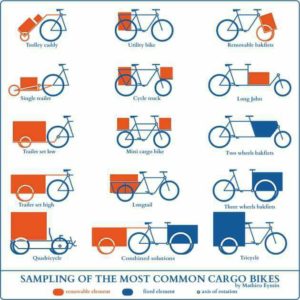Category Archives: Well done!
Crusing around New Orleans on Blue Bikes
Cargo bikes
I know we have already talked about cargo bikes. I also know the use of this kind of bikes will increase in the coming years as a result of optimizing deliveries in cities. Laws will restrict the use of cars and vans to deliver goods specially in downtown areas. In addition, both environmental and economic costs reduction will make it essential. Moreover, the reduction of noises is appreciated by neighbors. What is not always well known is the high diversity in cargo bikes.
In the picture bellow, one can see a variety of them. Some can carry objects in the rear, whereas some others can do it in the front. Furthermore, some cargo bikes allow to transport merchandises in the back as well as in the front. The fact of allowing removable elements makes them incredibly versatile. For those companies specialized in deliveries, cargo bikes with fixed elements constitute a good solution for the day-to-day activities. Ideally there is a cargo bike for every need.
24 Hours in Rotterdam
The Williamsburg Bridge
The Fastest Bike in the World
Velomobile
ELF solar car-bike
The European Mobility Week
The European Mobility Week started improving the sustainable movement in cities transportation. The European Commission created this event to give citizens alternatives to the use of cars in cities. Today, more than 2,312 cities from 48 countries follow this annual event and carry on with at least 551 mobility actions with the aim of promoting clean mobility. In addition, the European Mobility Week awards cities which have been doing a great effort to the path of sustainable mobility.
It also offers advices on how to cheer up green mobility in cities through European cities and beyond experiences in its Best Practice Guide in the 2017 edition. On the other hand, if you are a local authority, it is a good idea checking this handbook (http://www.mobilityweek.eu/fileadmin/user_upload/materials/participation_resources/2017/2017_EMW_Handbook.pdf), whereas if you want to organize a campaign or just want to be enlighten, have a look at the Thematic guidelines. The circle is closed as local authorities are encouraged to use it to test new transport measures and give back opinions from citizens. Local stakeholders can then discuss the different aspects of mobility and air quality, discover synergies and innovate solutions to reduce car-use and emissions, hence improving citizens health. Thus, actions aim at giving opportunities to pedestrians, cyclists and public transport.
For now, let’s see a practical example. During the 2017 European Mobility Week in Valencia, the city experienced a positive impact on green mobility. A specific magazine was edited with news and pieces of information. Among the activities, there was the Mobility Fair in the city hall square in which everybody could check alternatives to the more pollutant car mobility. On the Tuesday, the Children city was an event in which children were shown the surrounding of their schools and they symbolically penalize unsupportive, antisocial actions regarding mobility. This way, children are taught to recognize the positive actions instead of the harmful ones. Next, a workshop was done in which neighbors valued the urban public space and detected changing opportunity in order to improve the neighborhoods mobility. Moreover, engineers organized a meeting to discuss issues which linked mobility to road safety. Furthermore, the new app for the public bus system was presented. Besides, a film series and concerts were played each with focus on mobility. Finally, the Bike day took place in which more than 10,000 rode together to claim for the green mobility.
The XV Iberian Congress: Activities
As I recently talked about, the XV Iberian Congress about urban biking is one of the most important events which will take place in Valencia the next May. The city will vibrate with this international meeting and the organization guarantees 5 days of intense, high-instructive, deep-learning experience. If you want to register for the activities, you have to fill in the congress page (only in Spanish at the moment I write this post).
What about the activities? All the five days will be plenty of activities. On the 16th May a riding on Valencia will happen and Morten Kabell, Copenhagenize General Manager, will open the congress with the speech Bicycle and city. From Thursday 17th to Saturday 20th May, an impressive amount of activities will take place in three different locations. Round tables, speeches, discussion boards and presentations will delight the attendees, and participants will shared ideas and connections. Mobilities and genre, politics, European funding regarding bike infrastructures, logistics, digital tools for sustainable mobility, how to evaluate the quality politics in the urban cycling design, social benefits, technical route in Valencia, the bike tourim development, bike and children, the Bike Equity net, mass media and bikes, the bike logistics evolution, health and mobility, intermodality, citizen sponsorship, working with bikes, air quality measuring, urban transformation and neighbor struggle, … are some themes which will be treated in these days. Routes and parties will also be enjoyed. The closing event will be carried out by Lake Sagaris.
IMPORTANT: Plan in advance after checking the congress program as most activities are determined in parallel. Thus, it is impossible to assist to all of it.
Moreover, the third Cyclist Women Meeting will be a reality on Saturday and Sunday. Women will enjoy several workshops from secure traffic to bike mechanics at all levels, and two ridings: BTT and road riding. All these events are exclusive for women, so men are forbidden here.
Finally, a riding in the vegetable garden, one of the treasures of Valencia, is planned on Sunday morning, whereas the Con bici (the supra Spanish association regarding urban biking) assembly will say good bye to these extremely, emotional, passionate, full of bikeholics and fun days, period.
